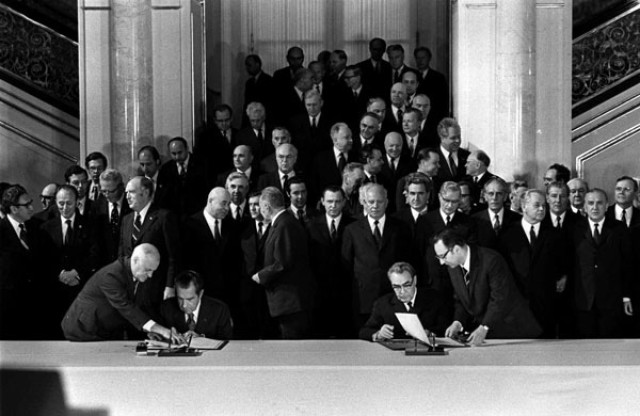The George Bush Presidential Library and Museum The Strategic Arms Reduction Treaty START was signed on July 31 1991 by President George HW. Negotiated between the United States and the Soviet Union as part of the Strategic Arms Limitation Talks the now-defunct Anti-Ballistic Missile ABM treaty was signed on May 26 1972 and entered into force on October 3 1972.
Strategic Arms Limitation Treaty Salt 2 Cold War Facts
Podpisanie dokumentu poprzedziły dwustronne rokowania w latach 19691972.

Strategic arms limitation treaty. Carters successor Ronald Reagan a vehement critic of SALT II during the 1980 presidential campaign agreed to abide by SALT II until its expiration on December 31 1985 while he pursued the Strategic Arms Reduction Treaty START and argued that research into the Strategic Defense Initiative SDI adhered to the 1972 ABM Treaty. At the time these. The treaty limited the number of Intercontinental Ballistic Missiles ICBMs and nuclear warheads either country could possess.
Strategic Arms Reduction Treaties 1991 and 1993 The Strategic Arms Reductions Treaties known as START I and START II were agreements to reduce the number of long-range nuclear weapons in the United States and the former Soviet Union. Setting equal aggregate ceilings and subceilings on strategic offensive weapon systems and imposing qualitative restraints on existing and future strategic systems. The first agreements known as SALT I and SALT II were signed by the United States and the Union of Soviet Socialist Republics in 1972 and 1979.
Strategic Arms Limitation Treaty SALT I pierwszy z układów o ograniczeniu zbrojeń strategicznych podpisany 26 maja 1972 roku między USA a ZSRR podczas wizyty prezydenta USA Richarda Nixona w Moskwie. Bush and Soviet President Mikhail Gorbachev. Strategic Arms Limitation Talks SALT negotiations between the United States and the Soviet Union that were aimed at curtailing the manufacture of strategic missiles capable of carrying nuclear weapons.
The START I Treaty which provides for the limitation and reduction of offensive strategic weapons entered into force in December 1994 after a period of stalemate which raised doubts about its future and that of its complement the START II Treaty. Soviet nuclear advantage in. Treaty Between The United States of America and The Union of Soviet Socialist Republics on the Limitation of Strategic Offensive Arms Together With Agreed Statements and Common Understandings Regarding the Treaty Signed at Vienna June 18 1979.
President Richard Nixon meeting in Moscow sign the Strategic Arms Limitation Talks SALT agreements. The Anti-Ballistic Missile Treaty ABM Treaty and the Interim Agreement on the Limitation of Strategic. During that period the United States and the Soviet Union negotiated the first agreements to place limits and restraints on some of their central and most important armaments.
Strategic Arms Limitation Treaty II Treaty 1979 Bilateral unratified agreement between the US. STRATEGIC ARMS LIMITATION TREATIES. The negotiations known as Strategic Arms Limitation Talks began in November 1969 and ended in January 1972 with agreement on two documents.
Strategic Arms Limitation Treaty By 1972 the first SALT treaty SALT I agreed that both countries would limit their number of ICBMs SALT II 1979 intended to accomplish nuclear parity SALT II got interrupted by the Soviet invasion of Afghanistan 1980 Ronald Reagan became President and ended. Strategic Arms Limitation Talks SALT I SALT I the first series of Strategic Arms Limitation Talks extended from November 1969 to May 1972. SALT agreements signed Soviet President Leonid Brezhnev and US.
Coming on the heels of the 1968 nuclear Non-Proliferation Treaty NPT the two components of the Strategic Arms Limitation Treaties SALT represented a willingness by the United States and the Soviet Union to constrain an arms race that both recognized was costly and potentially destabilizing.